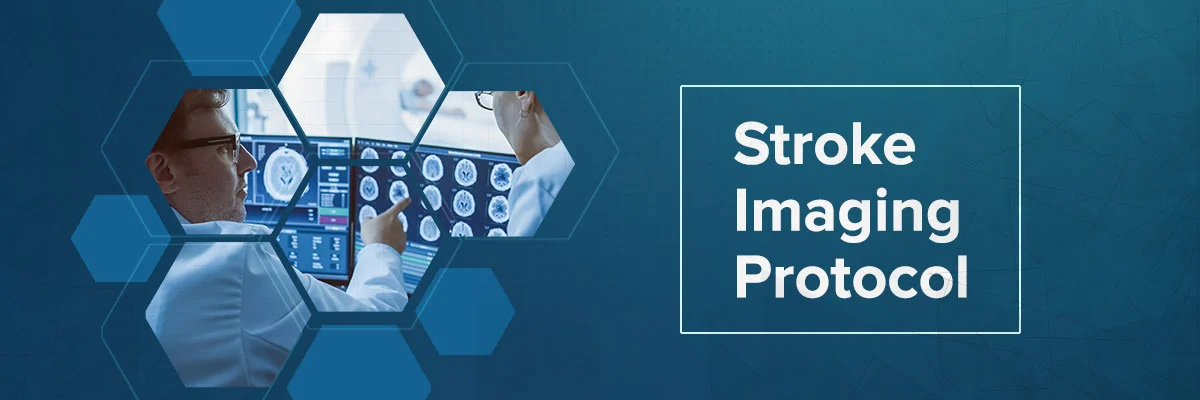Importance of Imaging Stroke Protocol

Stroke is the fifth leading cause of death and is predominantly the reason for increased incidences of serious, long-term disability in the United States. It has been reported that approximately 795,000 people suffer a stroke and more than 140,000 die annually because of it. On an average, someone in the United States has a stroke every 40 seconds.
As per WHO estimation, the stroke incidence and prevalence in the European countries, Iceland, Norway, and Switzerland were likely to increase from 1.1 million per year in 2000 to more than 1.5 million per year by 2025.
Another study conducted in India showed the cumulative incidence of stroke ranged from 105 to 152/100,000 persons per year, and the crude prevalence of stroke ranged from 44.29 to 559/100,000 persons during the past decade.
Although there have been many recent advances in medicine which have enabled better management of stroke, the above data makes a strong argument for the better planning of treatment for stroke patients.
Impact of Stroke
The impact of stroke greatly depends on the area of obstruction and how much brain tissue is affected. Once blood flow is blocked or slowed, the brain tissue is deprived of oxygen and other nutrients, and tissue death can occur within moments.
According to the National Stroke Association “every minute a stroke goes untreated, as many as 1.9 million neurons can die and may lead to long-term or even permanent loss of mobility, speech, and cognitive function.
Role of Imaging in Stroke
With the increasing number of stroke cases reported every year, dealing with stroke has become one of the most frequently performed tasks for a radiologist.
The goal of imaging evaluation in stroke cases is to expedite the diagnosis and obtain accurate information about the intracranial vasculature and brain perfusion. Appropriate image interpretation helps to evaluate patients suspected of acute stroke and transient ischemic attack (TIA). It guides in selecting the appropriate therapy as the subsequent treatments are vastly different.
Neurological imaging technique such as computed tomography is the modality of choice that plays a critical role in stroke identification in emergency settings. Owing to factors such as
- Ease of availability
- Short procedure time
- Can be conveniently performed on terminally ill patients who are dependent on support and monitoring devices computed tomography is preferred over any other diagnostic procedure for stroke evaluation.
The ability of CT to be used in combination with angiography and perfusion techniques increases the amount of information provided by the radiologist to multifold. Multimodal computed tomography evaluation involves a combination of non-enhanced, perfusion, and angiography techniques in CT and aids in the accurate detection of the infarct and the site of vascular occlusion. Hence it is important that the resultant images are correctly and immediately interpreted by the on-call radiologist. The need of the hour is the availability of a right specialist at the right time.The ability of a trained Neuroradiologist to read an intracranial large vessel occlusion correctly may improve door-to-needle times in acute stroke and could accelerate the management of acute stroke care.
Stroke Imaging Protocol
The quality of care delivered to stroke patients is dependent on two factors, how effectively and timely the diagnosis was made and how soon the treatment was initiated. However, in order to meet the above two parameters a well coordinated efforts between the multiple units of the hospital is a mandate.
This requires a seamless management between the ambulance services, paramedical staff; and in house hospital services. This cycle involves timely arrival of a patient to the emergency room; availability of the right diagnostic modality; quick, timely and accurate interpretation of the images; availability of critical value policy; well established line of communication between the radiologist & the treating doctor for clarification of any queries; and rapid treatment initiation. Of these, the quick, timely and accurate interpretation of the images; with a well-established line of communication between the radiologist and the treating physician requires implementation of a protocol for stroke management. Teleradiology plays a critical role in the efficient execution of this protocol.
Stroke Management
How an Imaging Stroke Protocol helps in Better Management of Emergency?
-
Prioritization of cases
A stroke protocol helps a radiologist prioritize cases. A programmed RIS system sends an alert “to be read next” to the radiologist and assigns cases to the Radiologist’s work lists. This ensures a timely reporting of the cases.
-
Assurance of TAT
Implementation of a stroke protocol ensures a quick turnaround time. Due to a narrow window period, a quick TAT, ensures implementation of the right treatment thus saving lives.
-
Critical value policy:
Critical positive findings noted on radiologic interpretations are reported by the radiologist to the treating doctor over a call in order to ensure the expedient clinical management of the patient. Critical value policy plays a major role in treating stroke cases as the treatment plan can be initiated immediately without waiting for the generation of report thereby preventing any delays that can result in an adverse outcome to the patient.
-
A line of communication between the radiologist and the treating doctors:
While working in an emergency setting, radiologists often provide only a brief analysis of the findings. In certain scenarios, treating doctor may need further clarification on the findings hence a strong line of communication between the radiologist and physician is required. This facilitates smooth handling of cases with recommendations and suggestions for follow up and further imaging, if required.
All of these elements are preserved and can be further facilitated by the implementation of Teleradiology.
